Assessment of the Resilience in SEPLS (Socio-Ecological Production Landscapes and Seascapes) in Yanuo Village, Xishuangbanna, Southwest China
Abstract
:1. Introduction
2. Materials and Methods
2.1. Study Area
2.2. Assessment of the Resilience in SEPLS
3. Results
3.1. Landscape Diversity and Ecosystem Protection
3.2. Biodiversity (Including Agricultural Biodiversity)
3.3. Knowledge and Innovation
3.4. Governance and Social Equity
3.5. Livelihoods And Well-Being
4. Discussion
4.1. Factors Affecting the Resilience in SEPLS in Yanuo Village
4.2. Importance of the Assessment Workshop for Sustainability
4.3. Proposal for an Assessment Framework
5. Conclusions
Author Contributions
Funding
Acknowledgments
Conflicts of Interest
References
- Fletcher, R.; Baulcomb, C.; Hall, C.; Hussain, S. Revealing marine cultural ecosystem services in the Black Sea. Mar. Policy 2014, 50, 151–161. [Google Scholar] [CrossRef]
- UNU-IAS; Bioversity International; IGES; UNDP (Eds.) Toolkit for the Indicators of Resilience in Socio-Ecological Production Landscapes and Seascapes; UNU-IAS Policy Report 38, 70; Bioversity International: Yokohama, Japan, 2014. [Google Scholar]
- UNU-IAS; IGES (Eds.) Mainstreaming Concepts and Approaches of Socio-Ecological Production Landscapes and Seascapes into Policy and Decision-Making (Satoyama Initiative Thematic Review Vol. 2); United Nations University Institute for the Advanced Study of Sustainability: Tokyo, Japan, 2016. [Google Scholar]
- Satoyama-Initiative. Available online: https://satoyama-initiative.org/about/ (accessed on 6 October 2019).
- Gu, H.Y.; Subramanian, S.M. Drivers of change in socio-ecological production landscapes: Implications for better management. Ecol. Soc. 2014, 19, 41. [Google Scholar] [CrossRef]
- Schaich, H.; Bieling, C.; Plieninger, T. Linking ecosystem services with cultural landscape research. GAIA 2010, 19, 269–277. [Google Scholar] [CrossRef]
- Castonguay, A.C.; Burkhard, B.; Muller, F.; Horgan, F.G.; Settele, J. Resilience and adaptability of rice terrace social-ecological systems: A case study of a local community’s perception in Banaue, Philippines. Ecol. Soc. 2016, 21, 15. [Google Scholar] [CrossRef]
- Fisher, B.; Costanza, R.; Turner, R.K.; Morling, P. Defining and classifying ecosystem services for decision making. Ecol. Econ. 2009, 68, 643–653. [Google Scholar] [CrossRef] [Green Version]
- Ouyang, Z.Y.; Wang, X.K.; Miao, H. A primary study on Chinese terrestrial ecosystem services and their ecological-economic values. Acta Ecol. Sin. 1999, 19, 607–613. [Google Scholar]
- Gomez-Baggethun, E.; Ruiz-Perez, M. Economic valuation and the commodification of ecosystem services. Prog. Phys. Geog. Earth Environ. 2011, 35, 613–628. [Google Scholar] [CrossRef] [Green Version]
- Berkes, F. Community-based conservation in a globalized world. Proc. Natl. Acad. Sci. USA 2007, 104, 15188–15193. [Google Scholar] [CrossRef] [Green Version]
- Fraser, E.D.G.; Dougill, A.J.; Mabee, W.E.; Reed, M.; McAlpine, P. Bottom up and top down: Analysis of participatory processes for sustainability indicator identification as a pathway to community empowerment and sustainable environmental management. J. Environ. Manag. 2006, 78, 114–127. [Google Scholar] [CrossRef]
- Sterling, E.J.; Betley, E.; Sigouin, A.; Gomez, A.; Toomey, A.; Cullman, G.; Malone, C.; Pekor, A.; Arengo, F.; Blair, M.; et al. Assessing the evidence for stakeholder engagement in biodiversity conservation. Biol. Conser. 2017, 209, 159–171. [Google Scholar] [CrossRef]
- Chan, K.M.; Balvanera, P.; Benessaiah, K.; Chapman, M.; Diaz, S.; Gomez-Baggethun, E.; Gould, R.; Hannahs, N.; Jax, K.; Klain, S.; et al. Opinion: Why protect nature? Rethinking values and the environment. Proc. Natl. Acad. Sci. USA 2016, 113, 1462–1465. [Google Scholar] [CrossRef] [PubMed] [Green Version]
- Daniel, T.C.; Muhar, A.; Arnberger, A.; Aznar, O.; Boyd, J.W.; Chan, K.M.; Costanza, R.; Elmqvist, T.; Flint, C.G.; Gobster, P.H.; et al. Contributions of cultural services to the ecosystem services agenda. Proc. Natl. Acad. Sci. USA 2012, 109, 8812–8819. [Google Scholar] [CrossRef] [PubMed] [Green Version]
- Holling, C.S. Resilience and stability of ecosystems. Annu. Rev. Ecol. S. 1973, 4, 1–23. [Google Scholar] [CrossRef] [Green Version]
- Béné, C.; Newsham, A.; Davies, M. Making the Most of Resilience. IDS in Focus Policy Briefings, 2013. 32. Brighton: IDS. Available online: https://opendocs.ids.ac.uk/opendocs/handle/20.500.12413/2370 (accessed on 10 November 2019).
- Takeuchi, K. Satoyama Initiative and Its Partnership: Lessons Learned for the Post-2020 Framework; Report at the Side Event at the CBD Regional Consultation Workshop on the Post-2020 Global Biodiversity Framework for Asia and the Pacific; The Satoyama Initiative: Nagoya, Japan, 2019. [Google Scholar]
- Long, C.L.; Zhou, Y.L. Indigenous community forest management of Jinuo people’s swidden agroecosystems in southwest China. Biodivers. Conser. 2001, 10, 753–767. [Google Scholar] [CrossRef]
- The Population Census Office of the State Council, National Bureau of Statistics. Tabulation on the 2010 Population Census of the People’s Republic of China. 2012. Available online: http://www.stats.gov.cn/tjsj/pcsj/rkpc/6rp/indexch.htm (accessed on 6 October 2019).
- Hill, R.; Dyer, G.A.; Lozada-Ellison, L.M.; Gimona, A.; Martin-Ortega, J.; Munoz-Rojas, J.; Gordon, I.J. A social-ecological systems analysis of impediments to delivery of the Aichi 2020 Targets and potentially more effective pathways to the conservation of biodiversity. Glob. Environ. Chang. Human Policy Dimens. 2015, 34, 22–34. [Google Scholar] [CrossRef] [Green Version]
- Surya, S. Landscape ecological urbanism for restoration of Pallikaranai Marsh Land, Chennai, Tamil Nadu. Procedia Technol. 2016, 24, 1819–1826. [Google Scholar] [CrossRef]
- Morrison, S.A. Designing virtuous socio-ecological cycles for biodiversity conservation. Biol. Conser. 2016, 195, 9–16. [Google Scholar] [CrossRef] [Green Version]
- Murray-Rust, D.; Dendoncker, N.; Dawson, T.P.; Acosta-Michlik, L.; Karali, E.; Guillem, E.; Rounsevell, M. Conceptualising the analysis of socio-ecological systems through ecosystem services and agent-based modelling. J. Land Use Sci. 2011, 6, 83–99. [Google Scholar] [CrossRef]
- Tengberg, A.; Fredholm, S.; Eliasson, I.; Knez, I.; Saltzman, K.; Wetterberg, O. Cultural ecosystem services provided by landscapes: Assessment of heritage values and identity. Ecosys. Serv. 2012, 2, 14–26. [Google Scholar] [CrossRef]
- Uehara, T.; Niu, J.; Chen, X.; Ota, T.; Nakagami, K.I. A sustainability assessment framework for regional-scale Integrated Coastal Zone Management (ICZM) incorporating Inclusive Wealth, Satoumi, and ecosystem services science. Sustain. Sci. 2016, 11, 801–802. [Google Scholar] [CrossRef]
- Landis, D.A. Designing agricultural landscapes for biodiversity-based ecosystem services. Basic Appl. Ecol. 2017, 18, 1–12. [Google Scholar] [CrossRef] [Green Version]
- Fagerholm, N.; Käyhkö, N.; Ndumbaro, F.; Khamis, M. Community stakeholders’ knowledge in landscape assessments—Mapping indicators for landscape services. Ecol. Indic. 2012, 18, 421–433. [Google Scholar] [CrossRef]
- Mace, G.M.; Norris, K.; Fitter, A.H. Biodiversity and ecosystem services: A multilayered relationship. Trends Ecol. Evol. 2012, 27, 19–26. [Google Scholar] [CrossRef] [PubMed]
- Saint-Pierre, C. Evolution of agroforestry in the Xishuangbanna region of tropical China. Agroforest. Sys. 1991, 13, 159–176. [Google Scholar] [CrossRef]
- Wang, J.R.; Long, C.L. Ethnobotanical study of traditional edible plants of Jinuo nationality. Acta Bot. Yunnan. 1995, 17, 161–168. [Google Scholar]
- Naeem, S.; Li, S. Biodiversity enhances ecosystem reliability. Nature 1997, 390, 507–509. [Google Scholar] [CrossRef]
- Folke, C. Traditional knowledge in social–ecological systems. Ecol. Soc. 2004, 9, 7. [Google Scholar] [CrossRef]
- Long, C.L. Plant diversity in swidden agroecosystems: A case study in Jinuo community of Xishuangbanna. In Regional Study on Biodiversity: Concepts, Frameworks, and Methods; Pei, S.J., Sajise, P.E., Eds.; Yunnan University Press: Kunming, China, 1995; pp. 53–77. [Google Scholar]
- Wu, T.; Petriello, M.A. Culture and biodiversity losses linked. Science 2011, 331, 30–31. [Google Scholar] [CrossRef]
- Sterling, E.J.; Filardi, C.; Toomey, A.; Sigouin, A.; Betley, E.; Gazit, N.; Newell, J.; Albert, S.; Alvira, D.; Bergamini, N.; et al. Biocultural approaches to well-being and sustainability indicators across scales. Nat. Ecol. Evol. 2017, 1, 1798–1806. [Google Scholar] [CrossRef]
- UNU-IAS; Bioversity International; Ministry of the Environment, Government of Japan. Policy Report, Indicators of Resilience in Socio-Ecological Production Landscapes (SEPLS); UNU-IAS: Yokohama, Japan, 2013. [Google Scholar]
- Lee, K.-C.; Karimova, P.G.; Yan, S.-Y.; Li, Y.-S. Resilience assessment workshops: A biocultural approach to conservation management of a rural landscape in Taiwan. Sustainability 2020, 12, 408. [Google Scholar] [CrossRef] [Green Version]
- Myers, N.; Mittermeier, R.A.; Mittermeier, C.G.; da Fonseca, G.A.B.; Kent, J. Biodiversity hotspots for conservation priorities. Nature 2000, 403, 853–858. [Google Scholar] [CrossRef] [PubMed]
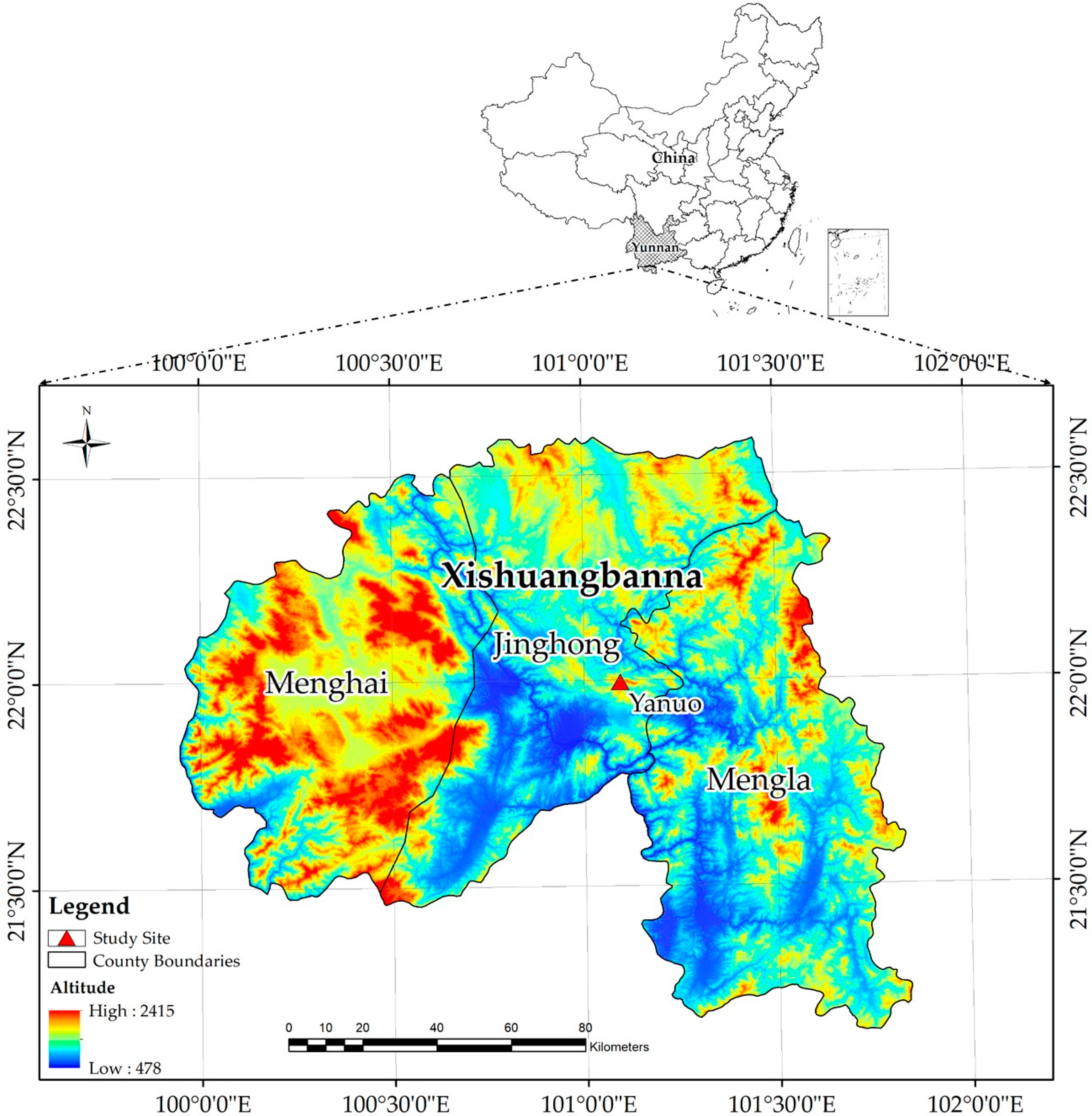
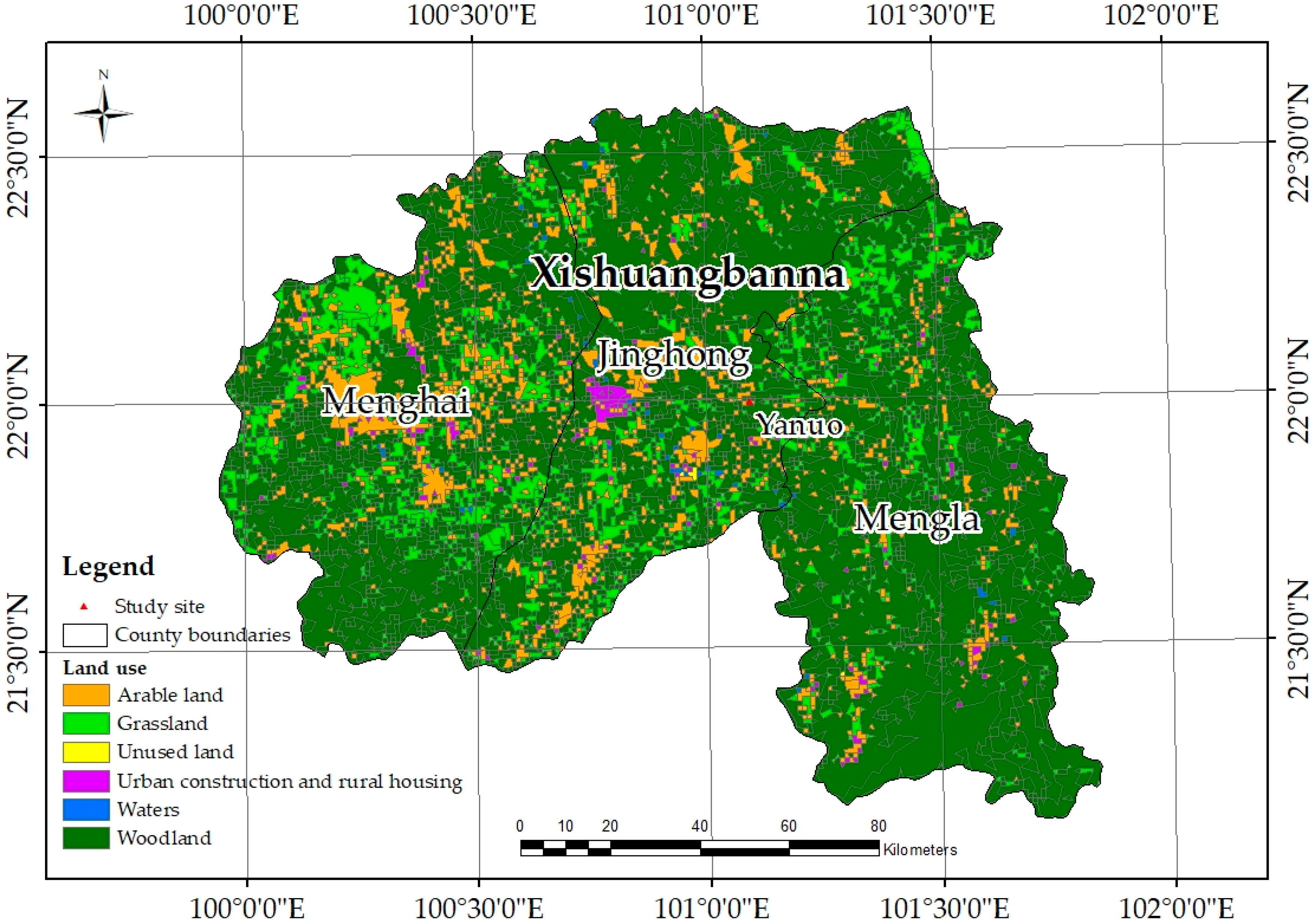

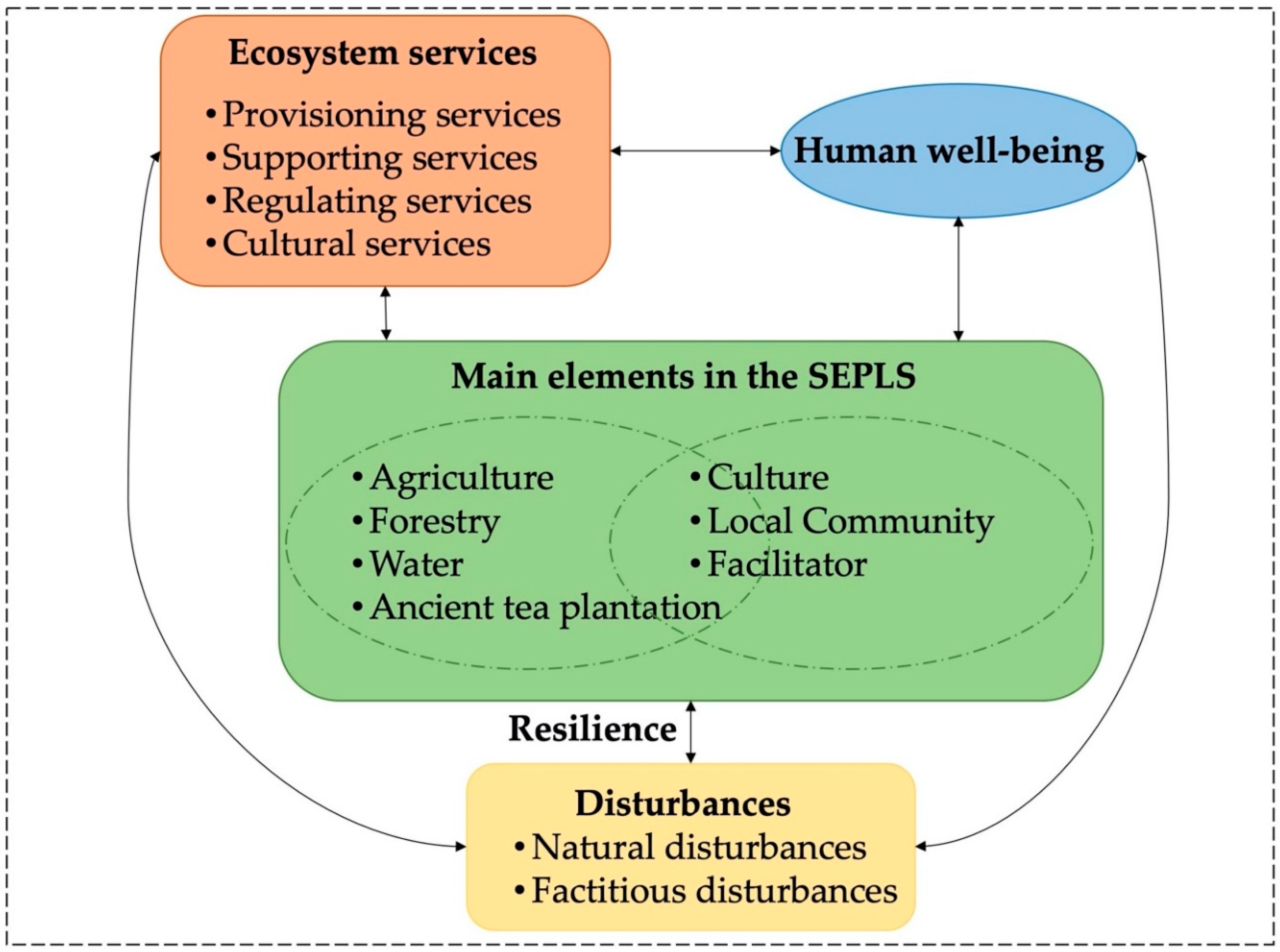
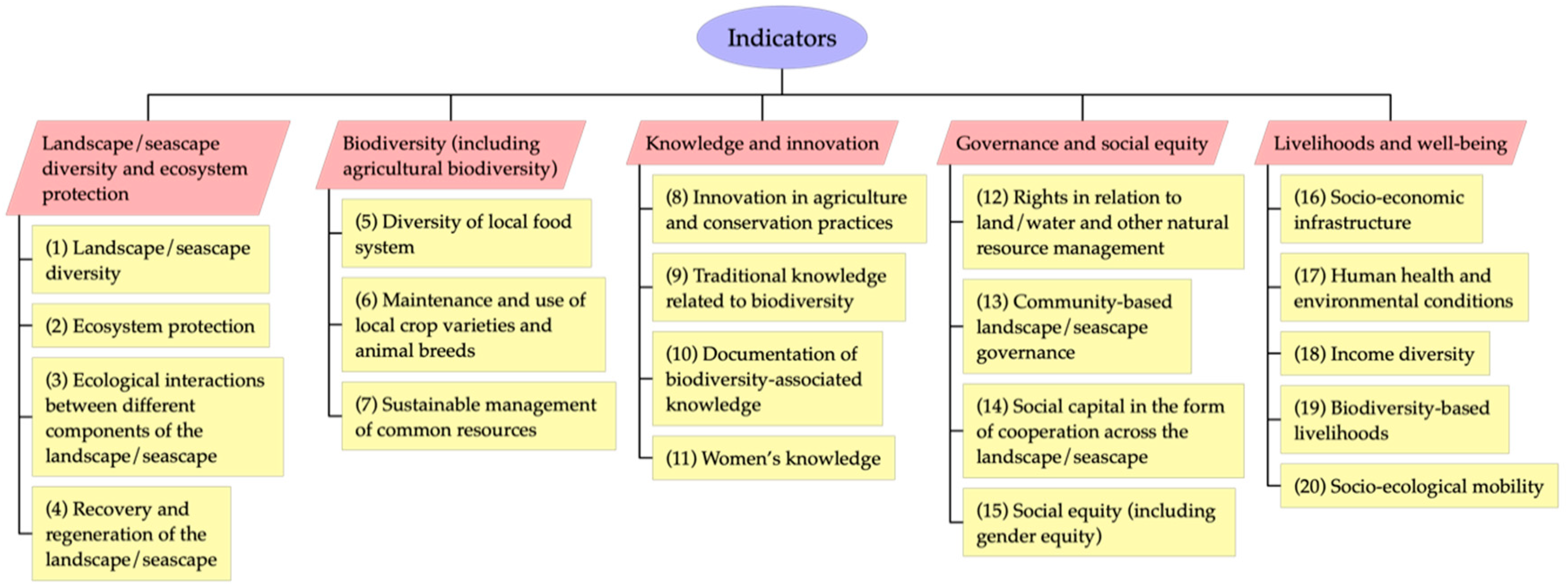
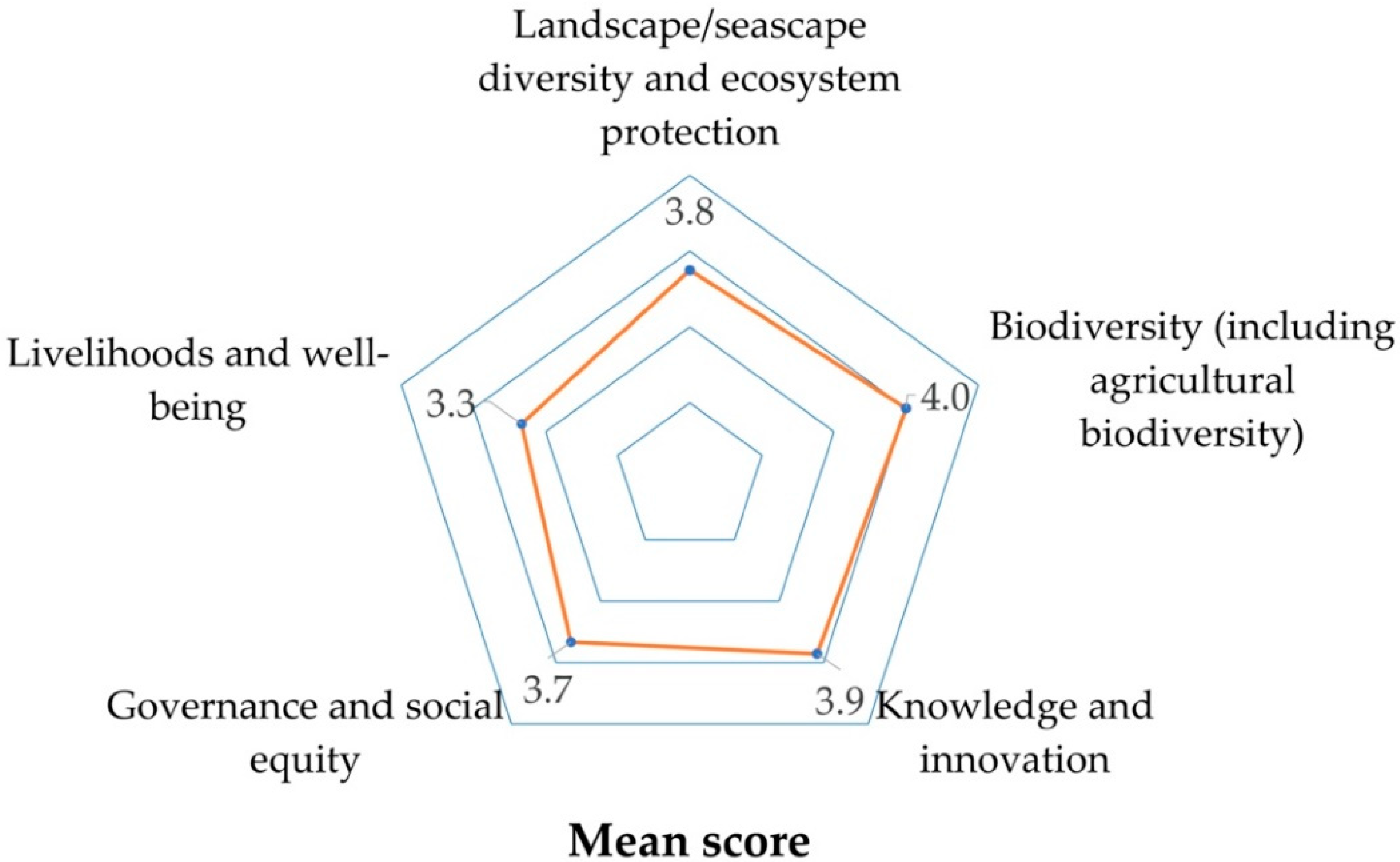
| Indicators | Mean Score | Mean Trend |
|---|---|---|
| Landscape/seascape diversity and ecosystem protection | 3.8 | |
| 5 | → |
| 4 | ↑ |
| 3 | ↑ |
| 3 | ↑ |
| Biodiversity (including agricultural biodiversity) | 4.0 | |
| 3 | → |
| 5 | ↓ |
| 4 | ↑ |
| Knowledge and innovation | 3.9 | |
| 4 | ↑ |
| 3 | ↓ |
| 4 | ↓ |
| 4 | ↓ |
| 3 | ↑ |
| 5 | ↓ |
| 4 | → |
| Governance and social equity | 3.7 | |
| 3 | ↑ |
| 4 | → |
| 4 | ↑ |
| Livelihoods and well-being | 3.3 | |
| 3 | ↑ |
| 4 | → |
| 3 | ↑ |
© 2020 by the authors. Licensee MDPI, Basel, Switzerland. This article is an open access article distributed under the terms and conditions of the Creative Commons Attribution (CC BY) license (http://creativecommons.org/licenses/by/4.0/).
Share and Cite
Yang, Y.; Bai, K.; Li, G.; Jarvis, D.I.; Long, C. Assessment of the Resilience in SEPLS (Socio-Ecological Production Landscapes and Seascapes) in Yanuo Village, Xishuangbanna, Southwest China. Sustainability 2020, 12, 3774. https://doi.org/10.3390/su12093774
Yang Y, Bai K, Li G, Jarvis DI, Long C. Assessment of the Resilience in SEPLS (Socio-Ecological Production Landscapes and Seascapes) in Yanuo Village, Xishuangbanna, Southwest China. Sustainability. 2020; 12(9):3774. https://doi.org/10.3390/su12093774
Chicago/Turabian StyleYang, Yunhui, Keyu Bai, Guanhua Li, Devra I. Jarvis, and Chunlin Long. 2020. "Assessment of the Resilience in SEPLS (Socio-Ecological Production Landscapes and Seascapes) in Yanuo Village, Xishuangbanna, Southwest China" Sustainability 12, no. 9: 3774. https://doi.org/10.3390/su12093774





